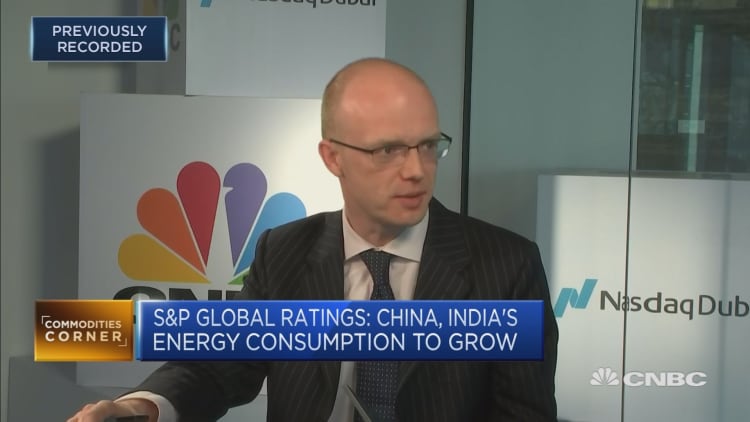
While crude exporting countries worry about bearish forecasts for energy markets, the big oil supermajors can withstand fluctuating oil prices in the coming year, one ratings agency says.
Cost cuts in the industry from previous years and promising cash flow potential mean the world's largest publicly traded international oil companies (IOCs) — Exxon, Shell, Chevron, BP, Eni and Total — needn't worry even if oil falls to $50 a barrel, according to S&P Global Ratings.
"Supermajors and these guys, the big players, the IOCs, they reckon they can break even with Brent at $50 (per barrel)," Simon Redmond, senior director of corporate ratings at S&P Global Ratings, told CNBC Thursday. "So, whether its $65 or $60, they're looking pretty good. And they should be able to generate meaningful cash flow."
The ratings agency forecasts global benchmark Brent crude, currently trading in the $58 to $60 per barrel range, at $65 a barrel in 2019 and $55 in longer term. Other forecasters see the commodity at anywhere between $55 to as high as $80 in the coming year, underlining the lack of consensus and predictability in the market.
Last weekend's announced OPEC production cut of 1.2 million barrels by January did little to boost prices, deepening concerns among exporters that pressures like waning demand and booming shale production in the U.S. will only push prices lower. Brent has fallen more than 25 percent from its early October highs of more than $86.
S&P expects aggregate crude production to grow — something OPEC likely won't be thrilled about.
Indeed, recent announcements by oil majors suggest they are cautiously optimistic for 2019. Chevron last week announced a capital expenditure increase in 2019, its first in four years. ConocoPhillips said it would allocate $6.1 billion to capital expenditures and expects to be able to generate free cash flow with U.S. benchmark West Texas Intermediate (WTI) at $40 a barrel. S&P forecasts WTI at $60 a barrel, with other agencies predicting prices closer to $50.
And IOCs plan their investments with a wide price range in mind to account for drops, BP Middle East President Michael Townshend told CNBC in late November.
"You don't plan on today's oil prices — you plan on a range," Townshend said. "We see a sensible range would be in that $50 to $70 range. And that's what we plan on."
Asked about the agency's "favorites", Redmond described Exxon as "top of the heap" in terms of resilience from a credit perspective, adding that the multinational had a "great diversified business" in both refining and petrochemicals. The American giant has an AA+ rating, having lost its AAA rating from S&P in 2016 thanks to the previous year's oil price crash.
Shell, Redmond noted, has significant production capacity in Brazil after its acquisition of British Gas in early 2016. Shares of Exxon and Shell are down 11 percent and 7 percent year to date, respectively.
Drilling jobs at risk
The companies, as well as Chevron and France's Total, Redmond said, enjoy "high ratings, so we expect some resilience through the cycle." Much of that resilience comes from years of cost cutting in the wake of the price crash in 2014 -- Shell, for instance, has slashed its unit costs by more than 50 percent.
These cuts, however, have put serious pressure on oilfield service companies and drillers. And as oil prices slide, thousands of jobs are at risk. "$50 oil is bad for the U.S. because it hurts American drillers and threatens to create problems in the credit market," Goldman Sachs' Jeff Currie told CNBC last month.
But the oil majors themselves are expected to remain in the clear for now, S&P believes, despite calls for a global energy transition toward more sustainable fuels.
"These are big companies, they've been around for a long time," Redmond said. "Yes, we can talk about environmental risks over longer term, but oil demand is still growing at 1.4 million barrels a day, and electric vehicles are not going to take a big chunk out of that in the next five years."


